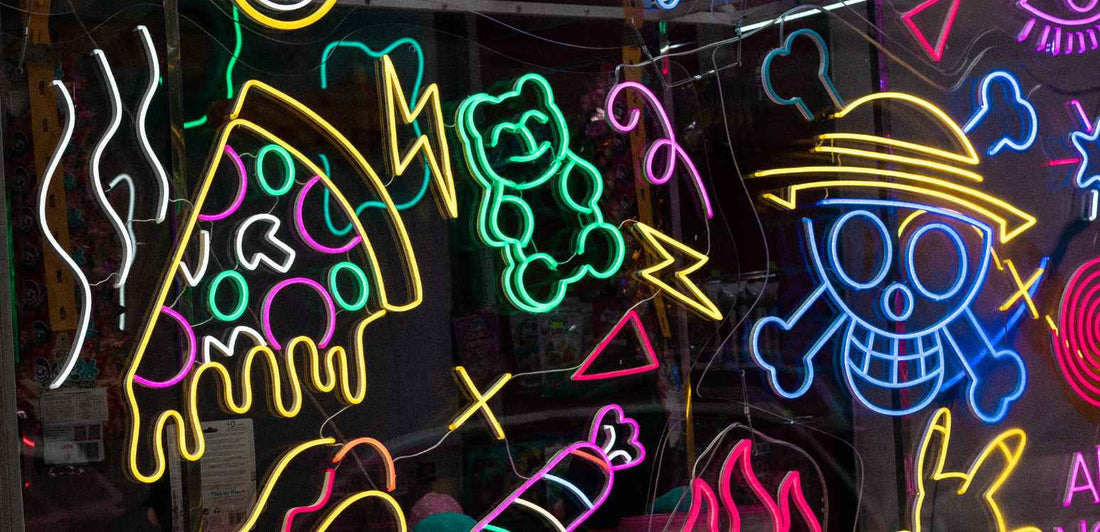Neon signs have long been iconic elements in both commercial and personal design. Whether it's a glowing shopfront, a statement wall in your home, or a branded display at an event, neon signs create an atmosphere that no other signage can quite match.
In this guide, we'll explore everything you need to know before purchasing a neon sign—from how they’re made and how they work, to energy use, cleaning, and placement. We’ll also compare traditional neon with modern LED neon signs, helping you make the right decision for your needs.
How Are Neon Signs Designed?
The process of designing a neon sign depends on whether you're opting for traditional neon or LED neon.
Traditional neon signs are made from soft lead glass tubes. These are heated and hand-bent into shape before being filled with noble gases such as neon or argon. The ends of the tube are fitted with pure-iron electrodes, which are then connected to a transformer via high-voltage cables. Once sealed and powered, the gas inside emits light through ionisation.
Modern LED neon signs use acrylic tubing instead of glass. Acrylic, also known as Perspex or Altuglas, is machine-cut to precise dimensions. The LEDs are embedded within the tubing, and the final components are mounted onto a backing board—usually acrylic, metal, or wood. Once assembled, each sign undergoes quality control to ensure it meets safety and appearance standards.
How Do Neon Signs Work?
Traditional neon signs work by exciting the gas inside their tubes. When an alternating current is applied, electrons and atoms collide, creating ions. As these ionised particles move and interact, they eventually release energy in the form of light—what we recognise as the neon glow.
LED neon signs operate using semiconductors. When electricity flows through materials like aluminium-gallium-arsenide, the movement of electrons generates light. These LEDs are placed close together to create a consistent glow, mimicking the look of classic neon without using gases or high-voltage power.
What Are the Benefits of Using Acrylic LED Signs?
LED neon signs have surged in popularity—and for good reason. Here are the standout advantages:
-
Safety: LED neon uses low voltage and doesn’t get hot, making it a safer option for homes, shops, and public spaces.
-
Durability: Acrylic is lighter, stronger, and more impact-resistant than glass. It doesn’t shatter like traditional neon tubing.
-
Energy Efficiency: LED signs use just 15–20% of the electricity traditional neon consumes, leading to up to 80% lower running costs.
-
Colour Variety: LED signs can support a near-unlimited range of colours, including animated and colour-changing effects.
-
Cool Operation: Thermally managed LEDs ensure the sign remains cool to the touch even after extended use.
-
Brightness and Clarity: LED signs are often brighter than their traditional counterparts and maintain consistent visibility from a distance.
What Are Custom Neon Signs and What Are Your Options?
One of the biggest draws of LED neon signage is the level of customisation available. Whether you're creating a sign for your home, event, or business, you can typically customise:
-
Font and letter design
-
Sign size and shape
-
Colour (including multi-colour options)
-
Backing style (clear, coloured, shaped)
Some manufacturers allow completely bespoke sizes, while others offer fixed templates. In most cases, design freedom is vast—limited only by imagination and the materials used.
What Do I Need to Prepare for a Neon Manufacturer?
You don’t need to be a graphic designer to order a custom neon sign. Most manufacturers can work from a simple sketch, a digital mock-up, or even a photo.
To speed up the process, it helps to prepare:
-
The text or image you want to display
-
Preferred size
-
Colour choices
-
Lettering style (script, block, modern, etc.)
-
The sign’s intended use: wall-mounted, freestanding, indoor or outdoor
Some manufacturers offer a design gallery to help you get ideas and visualise your options.
Do Neon Signs Use a Lot of Electricity?
Traditional neon signs are typically powered by a 240V transformer and use about 60–100 watts—roughly the same as a household light bulb.
LED neon signs, on the other hand, use around 15–20% of that power. Not only does this reduce running costs significantly, but it also makes them more sustainable and energy-efficient.
For businesses using multiple signs or running them for extended hours, the energy savings can be substantial over time.
How Long Do Neon Signs Last?
With proper care, neon signs—both traditional and LED—can last between 8 and 15 years. However, longevity depends on usage habits and electrical safety.
To extend your sign’s life:
-
Avoid leaving it switched on overnight unnecessarily
-
Protect it from power surges
-
Install it away from moisture or high-traffic areas
Following these tips can help prevent premature wear or damage.
Do Neon Signs Get Hot?
Yes—traditional neon signs do get hot. This is due to the high-voltage current and chemical reactions inside the gas-filled tubes.
LED neon signs do not get hot. Their low-voltage operation and thermal management systems ensure they remain cool, even after hours of use. This makes them a much safer option for indoor use, especially in homes or spaces with children and pets.
How to Clean Neon Signs
Keeping your neon sign clean helps preserve its appearance and function. Here’s how:
-
Always unplug the sign before cleaning.
-
Use a feather duster to remove surface dust.
-
For stubborn spots, use a nylon brush with soft bristles.
-
For stains, mix half a cup of water with half a cup of ammonia. Dampen a soft cloth and gently clean the surface.
-
Never use harsh chemicals or abrasive materials.
LED signs are easier to clean than traditional ones, thanks to their enclosed design and lack of fragile gas-filled tubes.
How Can I Use a Neon Sign for My Business?
Neon signs aren’t just decorative—they’re functional branding tools. Businesses use neon for:
-
Creating a memorable shopfront or window display
-
Highlighting promotions or brand messaging
-
Enhancing interior décor (e.g. reception walls or product displays)
-
Adding a fun, modern aesthetic to bars, salons, or offices
-
Supporting event booths and pop-ups
The flexibility of custom neon allows businesses to adapt the style to suit their tone—whether it’s elegant, quirky, or bold.
Choosing the Right Space for Your Neon Sign
Placement is just as important as design. Consider the following when deciding where to mount your sign:
-
Visibility: Choose high-traffic or eye-level locations if it’s meant to attract attention.
-
Safety: Keep it out of reach in areas where children or crowds gather.
-
Lighting: Use it in spaces that would benefit from additional light or mood enhancement.
-
Stability: Avoid places where it could be bumped or knocked over.
For home settings, consider bedrooms, kitchens, game rooms, or hallways. For business, windows, entrances, and feature walls work best.
FAQs
Q1: Are LED neon signs suitable for outdoor use?
Yes, but ensure the product is designed and rated for outdoor installation. Always ask the manufacturer for waterproof and UV-resistant options.
Q2: Can I dim my neon sign?
Many LED neon signs are dimmable with the right driver or remote. Traditional neon signs typically are not.
Q3: Do neon signs come with installation kits?
Most LED signs come with pre-drilled holes and wall-mounting hardware. Check with the supplier to confirm what’s included.
Q4: What’s the difference between acrylic and glass neon signs?
Acrylic signs use LED lights and are safer, cooler, and more energy-efficient. Glass neon signs use gas-filled tubes and offer a more classic aesthetic.
Q5: Can I get a battery-powered neon sign?
Some small LED neon signs can be battery operated, but larger installations usually require mains power for consistent brightness.

